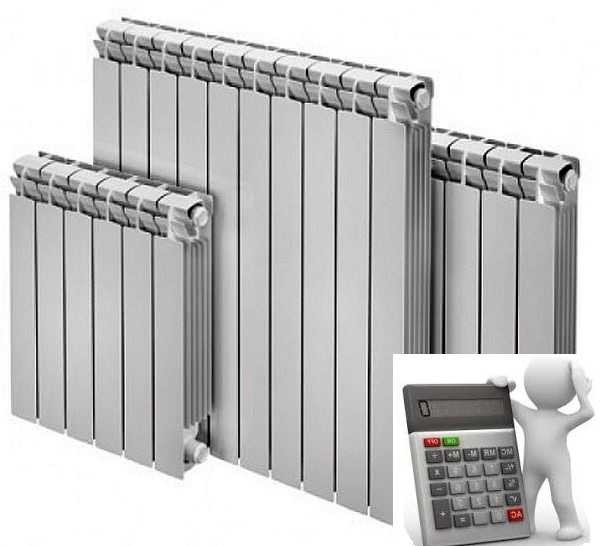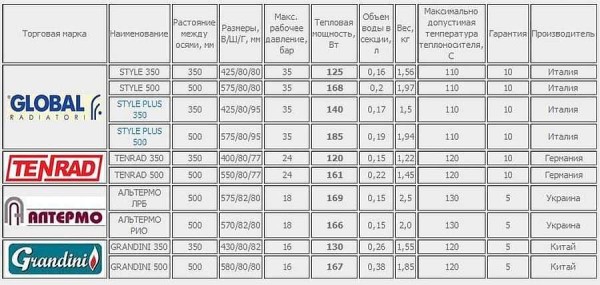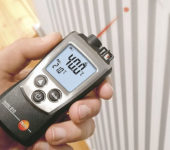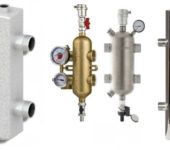How to calculate the number of radiator sections
When modernizing the heating system, in addition to replacing pipes, radiators are also changed. And today they are made of different materials, different shapes and sizes. Equally important, they have different heat dissipation: the amount of heat that can transfer to air. And this must be taken into account when calculating the radiator sections.
The room will be warm if the amount of heat that goes away is compensated. Therefore, in the calculations, the heat loss of the premises is taken as a basis (they depend on the climatic zone, on the material of the walls, insulation, window area, etc.). The second parameter is the thermal power of one section. This is the amount of heat that it can give out at the maximum system parameters (90 ° C inlet and 70 ° C outlet). This characteristic is necessarily indicated in the passport, often present on the packaging.

We do the calculation of the number of sections of heating radiators with our own hands, we take into account the characteristics of the premises and the heating system
One important point: when doing the calculations yourself, keep in mind that most manufacturers indicate the maximum figure they received under ideal conditions. Therefore, make any rounding up. In the case of low-temperature heating (the temperature of the heating medium at the inlet is below 85 ° C), they search for the heat output for the corresponding parameters or do a recalculation (described below).
The content of the article
Area calculation
This is the simplest technique that allows you to roughly estimate the number of sections required to heat a room. On the basis of many calculations, the norms for the average heating power of one square of the area were derived. To take into account the climatic features of the region, two norms were prescribed in SNiP:
- for regions of central Russia, from 60 W to 100 W is required;
- for areas above 60 °, the heating rate per square meter is 150-200 W.
Why is there such a wide range in the norms? In order to be able to take into account the materials of the walls and the degree of insulation. For concrete houses, the maximum values are taken, for brick houses, you can use the average. For insulated houses - the minimum. Another important detail: these standards are calculated for an average ceiling height - no higher than 2.7 meters.

How to calculate the number of radiator sections: formula
Knowing the area of the room, you multiply its heat consumption rate, which is most suitable for your conditions. You get the general heat loss of the room. In the technical data for the selected radiator model, find the heat output of one section. Divide the total heat loss by the power, you get their amount. Not difficult, but to make it clearer, let's give an example.
An example of calculating the number of radiator sections by the area of the room
Corner room 16 m2, in the middle lane, in a brick house. Batteries with a thermal power of 140 watts will be installed.
For a brick house, we take heat loss in the middle of the range. Since the room is angular, it is better to take a higher value. Let it be 95 watts. Then it turns out that it takes 16 m to heat the room2 * 95 W = 1520 W.
Now we count the number of radiators for heating this room: 1520 W / 140 W = 10.86 pcs. Round off, it turns out 11 pieces. So many radiator sections will need to be installed.
The calculation of radiators per area is simple, but far from ideal: the height of the ceilings is not taken into account at all. With a non-standard height, a different technique is used: by volume.
We count batteries by volume
There are norms in SNiP for heating one cubic meter of premises. They are given for different types of buildings:
- for brick 1 m3 requires 34 W of heat;
- for panel - 41 W
This calculation of radiator sections is similar to the previous one, only now it is not the area that is needed, but the volume and norms are different. The volume is multiplied by the norm, the resulting figure is divided by the power of one section of the radiator (aluminum, bimetallic or cast iron).

The formula for calculating the number of sections by volume
Sample calculation by volume
For example, let's calculate how many sections are needed in a room with an area of 16 m2 and a ceiling height of 3 meters. The building is brick-built. Let's take radiators of the same power: 140 W:
- Find the volume. 16 m2 * 3 m = 48 m3
- We consider the required amount of heat (the norm for brick buildings is 34 W). 48 m3 * 34 W = 1632 W.
- We determine how many sections are needed. 1632W / 140W = 11.66 pcs. Round off, we get 12 pieces.
Now you know two ways to calculate the number of radiators per room.
Read more about calculating room area and volume here.
Heat transfer of one section
Today the range of radiators is large. With the external similarity of the majority, thermal performance can differ significantly. They depend on the material from which they are made, on the size, wall thickness, internal section and on how well thought out the design.
Therefore, it is possible to say exactly how many kW in 1 section of an aluminum (cast-iron bimetallic) radiator can be said only in relation to each model. This data is indicated by the manufacturer. After all, there is a significant difference in size: some of them are tall and narrow, others are low and deep. The power of a section of the same height of the same manufacturer, but different models, may differ by 15-25 W (see the table below for STYLE 500 and STYLE PLUS 500). Even more tangible differences can be from different manufacturers.

Technical characteristics of some bimetallic radiators. Please note that the heat output of sections of the same height can have a noticeable difference.
Nevertheless, for a preliminary assessment of how many battery sections are needed for space heating, the average values of the heat output for each type of radiator were derived. They can be used for approximate calculations (data are given for batteries with a center distance of 50 cm):
- Bimetallic - One section emits 185 W (0.185 kW).
- Aluminum - 190 W (0.19 kW).
- Cast iron - 120 W (0.120 kW).
More precisely, how many kW in one section of a bimetallic, aluminum or cast iron radiator can you when you choose a model and decide on the dimensions. The difference in cast iron batteries can be very big. They are with thin or thick walls, due to which their thermal power significantly changes. Above are the average values for batteries of the usual shape (accordion) and those close to it. Radiators in the "retro" style have much lower thermal power.

These are the technical characteristics of the Turkish company Demir Dokum cast iron radiators. The difference is more than substantial. It can be even more
Based on these values and average norms in SNiP, the average number of radiator sections per 1 m was derived2:
- bimetallic section will heat 1.8 m2;
- aluminum - 1.9-2.0 m2;
- cast iron - 1.4-1.5 m2;
How to calculate the number of radiator sections using this data? It's even easier. If you know the area of the room, divide it by the factor. For example, room 16 m2, for heating it you will need approximately:
- bimetallic 16 m2 / 1.8 m2 = 8.88 pcs, round up - 9 pcs.
- aluminum 16 m2 / 2 m2 = 8 pcs.
- cast iron 16 m2 / 1.4 m2 = 11.4 pcs, round up - 12 pcs.
These calculations are only approximate. According to them, you can roughly estimate the cost of purchasing heating devices. You can accurately calculate the number of radiators per room by choosing a model, and then recalculating the number depending on the temperature of the coolant in your system.
Calculation of radiator sections depending on real conditions
Once again, we draw your attention to the fact that the thermal power of one battery section is indicated for ideal conditions. The battery will give out so much heat if its coolant at the inlet has a temperature of + 90 ° C, at the outlet + 70 ° C, while the room is maintained at + 20 ° C. That is, the temperature head of the system (also called "system delta") will be 70 ° C. What to do if your system does not have higher than + 70 ° C at the entrance? or is the room temperature + 23 ° C required? Recalculate the declared capacity.
To do this, you need to calculate the temperature head of your heating system.For example, at the supply you have + 70 ° C, at the outlet + 60 ° C, and in the room you need a temperature of + 23 ° C. We find the delta of your system: this is the arithmetic average of the temperatures at the inlet and outlet, minus the temperature in the room.

The formula for calculating the temperature head of the heating system
For our case, it turns out: (70 ° C + 60 ° C) / 2 - 23 ° C = 42 ° C. The delta for these conditions is 42 ° C. Next, we find this value in the conversion table (located below) and multiply the declared power by this coefficient. We will teach the power that this section can give for your conditions.
When recalculating, we proceed in the following order. Find in the blue colored columns a line with a delta of 42 ° C. It has a coefficient of 0.51. Now we calculate the thermal power of 1 section of the radiator for our case. For example, the declared power is 185 W, applying the found coefficient, we get: 185 W * 0.51 = 94.35 W. Almost two times less. It is this power that needs to be substituted when calculating the radiator sections. Only taking into account the individual parameters will the room be warm.











